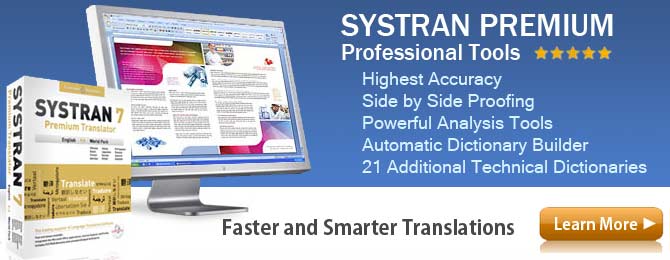Spanish Expansion Factor
Did you know that when you you translate a document from English to Spanish, the document's content expands? This is called the "expansion factor" of language. The reason for this "expansion factor" is due to the linguistic and grammar rules of the Spanish language. For example, a Spanish translator will often need to use two, three or even more words to convert a single English compound word. On average a Spanish document after translation will increase by 25% or more than the original English document.
Here is one example of how the volume of words expand:
clockwise = 1
word in English
a la derecha = 3 words
in Spanish
Translating Spanish and your Formatting
The good news is that if you are working with Systran professional translation programs you can retain much of your document's formatting. Text in tables, bold, bullets, italics, colors, paragraphs, titles and indents are all maintained during the translation process. Even though the software can maintain these elements you may still want to make some adjustments if you need to control the overall size of the document after translation.
Tips on Controlling the overall size of the Document after Translation
If you are working with documents that have been formatted there are a few things you can do to maintain the formatting and style of your document, as well as the size after translation.
- Resize Fonts - you can use a slightly smaller font to make the document appear the same size.
- Change Font Style - remember that some fonts are naturally thinner with less space between the letters, play with font styles.
- Margins - adjust the margins a little to give the illusion that the document has not changed in volume.
- White Space - with your original document you can increase the white space in anticipation that the Spanish translated text will fit into the same space.
- Use Tables - with the more professional translation programs on the market they can effectively translate text that is in tables and cells without changing the formatting.
- Images - with graphics and images you should place them in-line with the text. This will keep the image aligned with the content of the page.
Times when English to Spanish Expansion is even more important to Consider
If you are translating internal documents or letters, the overall length is not that important, but there are times when it should be considered due to costs.
- Professional Printing - if you are translating a book from English to Spanish and having it professional printed, the cost of printing 25% more pages should be considered.
- Web Design - many web pages use graphics for buttons, changing the text on the buttons can cause design problems and require graphical changes.
- Marketing Brochures - the layout for many marketing materials can be limited, expanding the text can cause layout changes.
When working with translator software you will find that your orginal (source document) will always be different in size than your translated file (target document). Each language will be different, some will expand while others may be more compact. You can test translate a language with software to get an idea of how your final document will look after translation.






